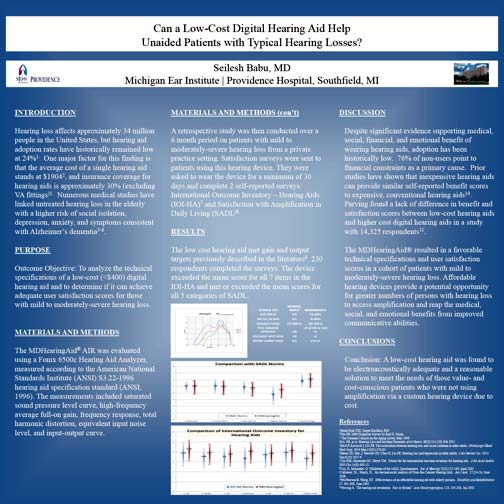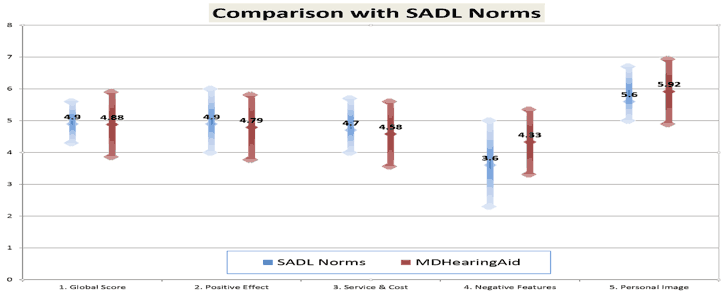The MDHearingAid AIR was the focus of research presented at the Combined Section Meeting of the Triological Society Jan 22-24, 2015, San Diego, CA.. Dr. Seilesh Babu, nationally known neurotologist, presented original research conducted on the AIR entitled “Can a Low-Cost Digital Hearing Aid Help Unaided Patients with Typical Hearing Losses?”

Can a Low-Cost Digital Hearing Aid Help Unaided Patients with Typical Hearing Losses?
by Seilesh Babu, MD – Michigan Ear Institute & Providence Hospital, Southfield, MI
INTRODUCTION
Hearing loss affects approximately 34 million people in the United States, but hearing aid adoption rates have historically remained low at 24%1. One major factor for this finding is that the average cost of a single hearing aid stands at $19042, and insurance coverage for hearing aids is approximately 30% (excluding VA fittings)1. Numerous medical studies have linked untreated hearing loss in the elderly with a higher risk of social isolation, depression, anxiety, and symptoms consistent with Alzheimer’s dementia3-6.
PURPOSE
Outcome Objective: To analyze the technical specifications of a low-cost (<$400) digital hearing aid and to determine if it can achieve adequate user satisfaction scores for those with mild to moderately-severe hearing loss.
MATERIALS AND METHODS
The MDHearingAid AIR was evaluated using a Fonix 6500c Hearing Aid Analyzer, measured according to the American National Standards Institute (ANSI) S3.22-1996 hearing aid specification standard (ANSI, 1996). The measurements included saturated sound pressure level curve, high-frequency average full-on gain, frequency response, total harmonic distortion, equivalent input noise level, and input-output curve.
A retrospective study was then conducted over a 6 month period on patients with mild to moderately-severe hearing loss from a private practice setting. Satisfaction surveys were sent to patients using this hearing device. They were asked to wear the device for a minimum of 30 days and complete 2 self-reported surveys: International Outcome Inventory – Hearing Aids (IOI-HA)7 and Satisfaction with Amplification in Daily Living (SADL)8.
RESULTS
The low cost hearing aid met gain and output targets previously described in the literature9. 230 respondents completed the surveys. The device exceeded the mean score for all 7 items in the IOI-HA and met or exceeded the mean scores for all 5 categories of SADL.
DISCUSSION
Despite significant evidence supporting medical, social, financial, and emotional benefit of wearing hearing aids, adoption has been historically low. 76% of non-users point to financial constraints as a primary cause. Prior studies have shown that inexpensive hearing aids can provide similar self-reported benefit scores to expensive, conventional hearing aids10. Parving found a lack of difference in benefit and satisfaction scores between low-cost hearing aids and higher cost digital hearing aids in a study with 14,325 respondents11.
The MDHearingAid resulted in a favorable technical specifications and user satisfaction scores in a cohort of patients with mild to moderately-severe hearing loss. Affordable hearing devices provide a potential opportunity for greater numbers of persons with hearing loss to access amplification and reap the medical, social, and emotional benefits from improved communicative abilities.
CONCLUSIONS
Conclusion: A low-cost hearing aid was found to be electroacoustically adequate and a reasonable solution to meet the needs of those value- and cost-conscious patients who were not using amplification via a custom hearing device due to cost.
References:
1 MarkeTrak VIII, Sergei Kochkin, PhD
2 The HR 2006 Dispenser Survey by Karl E. Strom
3 The National Council on the Aging survey, May 1999
4 Lin, FR, et al. Hearing Loss and Incident Dementia Arch Neurol. 68(2):214-220, Feb 2011
5 Mick P, Kawachi I, Lin FR. The association between hearing loss and social isolation in older adults. Otolaryngol Head Neck Surg. 2014 Mar;150(3):378-84
6 Mener DJ, Betz J, Genther DJ, Chen D, Lin FR. Hearing loss and depression in older adults. J Am Geriatr Soc. 2013 Sep;61(9):1627-9
7 Cox RM, Alexander GC, Beyer CM. Norms for the international outcome inventory for hearing aids. J Am Acad Audiol. 2003 Oct;14(8):403-13
8 Cox, R, Alexander, G. Validation of the SADL Questionnaire. Ear & Hearing 22(2):151-160, April 2001
9 Callaway, SL , Punch, JL. An electoacousitc analysis of Over-the-Counter Hearing Aids. Am J Aud. 17:(14-24, June 2008
10 McPherson B, Wong, ET. Effectiveness of an affordable hearing aid with elderly persons. Disability and Rehabilitation 27, 601-609, June 2005
11 Parving A. The hearing aid revolution: Fact or fiction? Acta Otolaryngologica, 123, 245-248, Jan 2003


